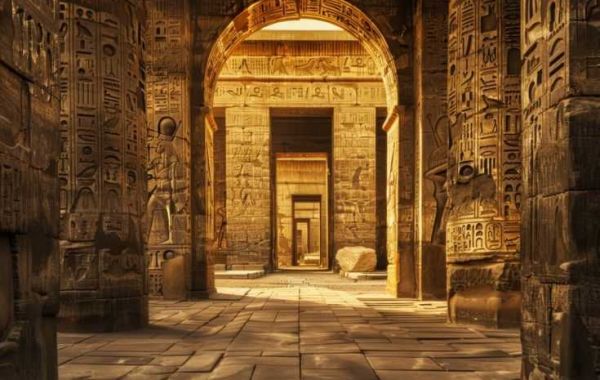Cairo, the sprawling capital of Egypt, is a city where the echoes of ancient history resonate in every corner. Known as the "City of a Thousand Minarets," Cairo’s vibrant streets pulse with life, but beneath its bustling modern facade lies a deeper, more enigmatic past. The city is a gateway to the wonders of Ancient Egypt, from the awe-inspiring Pyramids of Giza to the hidden treasures of the Nile. In this article, we explore the mysteries of Ancient Cairo, uncovering the secrets that have intrigued explorers, archaeologists, and historians for centuries.
1. The Pyramids of Giza: Enigmas in Stone
No exploration of Ancient Cairo’s mysteries can begin without mentioning the Pyramids of Giza, perhaps the most iconic and mystifying structures in the world. These colossal monuments, built over 4,500 years ago, still baffle modern engineers with their sheer size, precision, and complexity. The Great Pyramid of Khufu, the largest of the three, stands as a testament to ancient Egypt’s advanced knowledge of mathematics, astronomy, and construction.
One of the enduring mysteries surrounding the pyramids is how they were built with such precision using the tools and technologies available at the time. Theories range from sophisticated engineering techniques to more outlandish suggestions involving lost civilizations or even extraterrestrial help. Despite extensive research, the exact methods used to transport and position the massive limestone blocks remain a subject of debate.
Additionally, the purpose of the pyramids continues to intrigue scholars. While they are generally accepted as tombs for the pharaohs, the alignment of the pyramids with celestial bodies and the precise mathematical ratios found within their design suggest deeper spiritual or cosmic significance.
2. The Sphinx: Guardian of Mysteries
Standing guard near the Pyramids of Giza is the Great Sphinx, an enormous limestone statue with the body of a lion and the head of a human, believed to represent Pharaoh Khafre. The Sphinx is one of Cairo’s most iconic symbols and holds a prominent place in the city’s ancient mythology. Yet, the Sphinx is shrouded in mystery, particularly regarding its construction, purpose, and age.
Some theories suggest that the Sphinx may be far older than traditionally thought, with its origins possibly dating back to a forgotten civilization that predated the ancient Egyptians. Erosion patterns on the statue’s body have led some to propose that it may have been carved thousands of years before Khafre’s reign, during a time of heavier rainfall in Egypt. This controversial theory remains debated, as no definitive evidence has been found to confirm an earlier date.
The hidden chambers beneath the Sphinx also add to its allure. There have been claims of secret tunnels and hidden rooms beneath the monument, which some believe could contain ancient records or treasures. While these claims remain speculative, the Sphinx’s air of mystery continues to captivate the imagination of visitors and researchers alike.
3. The Lost City of Memphis
Ancient Cairo was once home to Memphis, the capital of Egypt during the Old Kingdom and one of the greatest cities of antiquity. Founded around 3100 BCE by King Menes, Memphis was a center of political and religious power, housing grand temples, palaces, and statues. However, much of the city’s splendor has been lost to time, with only ruins and fragments remaining.
The mystery of Memphis lies in its gradual decline and eventual disappearance. Despite its significance, the city’s exact layout and many of its treasures remain hidden beneath layers of sediment and modern construction. Excavations have uncovered statues of Ramses II and the remains of the Temple of Ptah, but large parts of the city remain unexplored. The ruins of Memphis, located just outside modern Cairo, continue to entice archaeologists with the possibility of uncovering more about this ancient metropolis.
4. The Hanging Church and Coptic Cairo
Cairo is not only the gateway to Ancient Egypt’s pharaonic past but also a city rich in Christian history. The area known as Coptic Cairo is home to one of the oldest Christian communities in the world, and its churches hold their own share of mysteries. One of the most famous is the Hanging Church, or the Church of the Virgin Mary, which dates back to the 3rd century.
El Gouna The Red Sea’s Hidden Gem for Spa and Relaxation
Spa Services in Hurghada From Makadi Bay to Soma Bay and El Gouna
The church’s name comes from its location, suspended above a Roman fortress gate. Inside, the church is a blend of intricate carvings, ancient mosaics, and relics that have drawn pilgrims for centuries. The mysteries of the Hanging Church are tied to its relics and legends, particularly the belief that the church was visited by the Holy Family during their flight to Egypt. While no definitive proof has been found, the legend persists, making it a place of deep spiritual significance.
5. The Hidden Tunnels of Cairo
Beneath the streets of Cairo lies a network of tunnels and catacombs that add to the city’s mystery. These underground passages are believed to date back to the pharaonic and medieval periods, used for various purposes such as defense, religious rituals, and secret burial sites. Some researchers believe that these tunnels could connect major landmarks like the Pyramids of Giza and the Sphinx, although much of this network remains uncharted.
In Islamic Cairo, particularly around the Citadel of Saladin and the Mosque of Ibn Tulun, stories of hidden chambers and passages abound. Some legends suggest that these tunnels were used by ancient rulers to escape during sieges or as storage for treasures. While many of these claims are based on myth, recent excavations have uncovered parts of these subterranean networks, hinting at the potential for further discoveries.
6. The Egyptian Museum’s Unexplained Artifacts
The Egyptian Museum in Cairo is home to one of the world’s most extensive collections of ancient Egyptian artifacts, including the treasures of Tutankhamun and countless other relics. Yet, among its vast collection are objects that continue to baffle scholars. One such artifact is the so-called “Dendera Light,” a relief found in the Temple of Hathor at Dendera, which some believe depicts an ancient form of electrical technology.
While mainstream Egyptologists dismiss this theory, the relief has sparked debates about whether the ancient Egyptians possessed knowledge of advanced technologies that have since been lost. Other mysterious artifacts in the museum include items with unknown origins or purposes, such as intricate carvings of figures with elongated heads or depictions of what some interpret as aircraft-like objects.
Conclusion
Cairo, a city that bridges the ancient and modern worlds, remains a place of deep intrigue. Its mysteries, from the Pyramids and Sphinx to the hidden tunnels and enigmatic artifacts, continue to captivate both scholars and visitors. As the gateway to Egypt’s ancient civilization, Cairo holds the keys to countless secrets that have yet to be fully unraveled. The city’s rich history, combined with its enduring mysteries, ensures that it will remain a source of fascination and wonder for generations to come.






